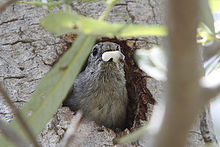Fecal sac



A fecal sac (also spelled faecal sac) is a mucous membrane, generally white or clear with a dark end,
Not all species generate fecal sacs. They are most prevalent in
Removal of fecal material helps to improve nest sanitation, which in turn helps to increase the likelihood that nestlings will remain healthy.
Scientists can use fecal sacs to learn a number of things about individual birds. Examination of the contents of the sac can reveal details of the nestling's
References
- ^
Choiniere, J.; Mowbray Golding, C.; Vezo, T. (2005). What's That Bird?. ISBN 1-58017-554-6.
- ^
Elphick, C.; Dunning, Jr, J. B.; Sibley, D. (2001). The Sibley Guide to Bird Life & Behaviour. ISBN 0-7136-6250-6.
- ^ a b
Campbell, B.; Lack, E. (1985). A Dictionary of Birds. ISBN 0-85661-039-9.
- ^ a b
O'Connor, R. J. (1984). The Growth and Development of Birds. ISBN 0-471-90345-0.
- The Wilson Bulletin. 78 (1): 47–56. Archived from the original(PDF) on 2008-10-10. Retrieved 2009-12-17.
- S2CID 53194945.
- ^
Ehrlich, P. R; Dobkin, D. S; Wheye, D.; Pimm, S. L. (1994). The Birdwatcher's Handbook. ISBN 0-19-858407-5.
- ^
Mockler, M. (1992). Birds in the Garden. ISBN 1-85079-217-8.
- ^
Alcorn, G. D. (1991). Birds and Their Young. ISBN 0-8117-1016-5.
- ^
Read, M. (2005). Secret Lives of Common Birds. ISBN 0-618-55871-3.
- S2CID 198238633.
- JSTOR 1368982.
- ^
Stake, M. M.; Cavanagh, P. M. (2001). "Removal of Host Nestlings and Fecal Sacs by Brown-headed Cowbirds". S2CID 88221603.
- ^ Brickle, N. W.; Harper, D. G. C. (1999). "Diet of Nestling Corn Buntings Miliaria Calandra in Southern England Examined by Compositional Analysis of Faeces". .
- ^ Smith, G. T.; Calver, M. C. (1984). "The Diet of the Nestling Noisy Scrub-Bird, Atrichornis Clamosus". .
- ^
Custer, T. W.; Custer, C. M.; Stromborg, K. L. (1997). "Distribution of Organochlorine Contaminants in Double-crested Cormorant Eggs and Sibling Embryos". S2CID 9042213.
- ^
Bibby, C. J. (2000). Bird Census Techniques (2nd ed.). ISBN 0-12-095831-7.
